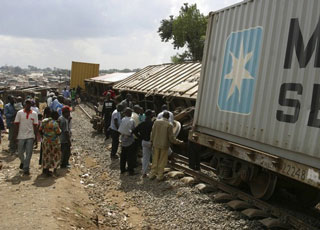
By Michael Madill
Rift Valley Railways (RVR) is off the rails. The January 15 deadline for RVR to meet a Shs100b ($50 million) investment commitment expired, triggering action by Kenya and Uganda to revoke RVR’s concession and to negotiate the construction of a competing rail line. Though RVR is fighting these actions in court, the privatisation scheme that was supposed to revive Uganda’s exporting businesses and revitalise the East African Community (EAC) trade has failed.
While the economics of a $500m re-capitalisation of RVR or a new concession of comparable value are debated in Transport ministries in Kampala and Nairobi, other EAC members to the South are advancing a programme which could leave Uganda struggling on the sidelines of a surge in rail-carried trade.
Last month Tanzania, Rwanda and Burundi agreed to develop rail links between Dar es Salaam and Kigali and the trading hub of Gitenga in Burundi. Isaka on the border between Shinyanga and Tabora in Tanzania would link the Central Corridor Railway with new track and speed access to regional and world markets for Rwanda’s and Burundi’s exports.
Reliable, efficient connections between Uganda and countries in the region and world markets are critical if exports are to grow. While the government announced Shs1.1 trillion or about $700m in new spending on roads to link Uganda better to South Sudan and northwest Tanzania, investment in railways which could accelerate inter-regional trade and support the growth of inter-modal freight are stuck at political bottlenecks. More freight can move by rail than by road, and move quicker and at comparable tonnes-per-kilometre cost to road freight for the same point-to-point journey.
Uganda’s exports increased around 20% to $2.4b in 2008 according to government figures. Some of this growth was attributed to a recovery in coffee prices, but one third of the total value (about $785m) was remittances by expatriates. This means Uganda’s single most valuable export is its people, and that its single biggest risk is the loss of remittances. The impact of the economic meltdown on remittances will likely surface in trade figures for 2008, but the data will likely show they have declined. Yet the government claim their 2009 export target is $5b. Exports must double in less than two years in order to make this target feasible. Will manufactured and services exports increase to fill the gap left by remittances? It depends, at least in part, on whether Uganda’s exporting infrastructure is capable of accommodating increased traffic.
How does Uganda plan to double exports in 18 months with the same road and rail network it has today? Its proposed investment in roads may come to fruition, and if it does these roads will connect Kampala better with Congo, Rwanda, Tanzania and South Sudan. But it is uncertain whether the scale of economic activity in Congo or South Sudan will increase enough to make those roads super-profitable. The RVR will contribute virtually nothing over this period as negotiations on its future proceed, and the proposed Open Access venture for an alternative railway will not be completed during this time.
A planned maritime freight service for Lake Victoria suffers viability concerns. So, any increase in exports by end of 2009 must be put through existing infrastructure. Where, though, are the goods? The volume of coffee exported in 2007 grew by only 2.8% despite the sharp increase in value. Only flowers and tobacco exports contributed volume growth near 20% besides their value increases. The only other exported commodity to increase substantially in volume was electricity, about 12.5%. But electricity does not ride on a truck or train. If exports are to double in 18 months there is very little data to support this assumption. And if hopes are pinned on a significant rise in coffee prices without steep increases in volume, then investment in additional infrastructure is unjustified. Coffee shipments data from the end of 2008 are encouraging but prices remain volatile and there is evidence that increased shipments were seasonal.
Even if exports increase substantially and the road and rail networks are greatly improved, Uganda faces new competition for exports and for haulage of exported goods. The building of the Isaka-Kigali-Gitenga extension to Tanzania’s railroads will make Rwanda and Burundi less dependent on road or rail traffic through Uganda and render maritime freight on Lake Victoria obsolete for exports destined for Southern Africa and overseas. As this project goes ahead the pressure to fix RVR or construct a competing line to Mombasa will mount. But with Rwanda no longer dependent on Uganda’s infrastructure the case for new investments in roads worsens slightly and for rail worsens somewhat more. These concerns could recede if there were a large increase in volume and value of trade with South Sudan, which could justify roads investment and the repair and extension of the Uganda Railways line at Gulu. But where is the money? If new investments in road and rail are not primarily donor funded, as government claimed, they must rely on increases in revenue and export earnings. If coffee prices fall or remittances dry up and the credit crunch continues, the expected funds will not materialise. Isn’t planning to increase exports using funds from increased exports to boost infrastructure just a game of smoke and mirrors?
****
Mr Madill is Adjunct Professor of Government, Oakton Community College, USA
mmadill@oakton.edu
 The Independent Uganda: You get the Truth we Pay the Price
The Independent Uganda: You get the Truth we Pay the Price


